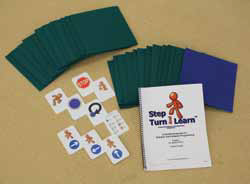Step Turn and Learn, Level 1
By Ken Roberts
Posted on 2013-01-25
This product is an idea for introducing young children to skills they will use for robotics and computer programming. Level 1 includes lightweight, flexible floor tiles, cards, and a guide booklet. Students tried Step Turn And Learn both in the classroom and outdoors. Any floor grid will do indoors, even a taped carpet. The tiles provided make it easy to take the activity outside where there might be more room for students to watch one another. The website directs viewers to a video. This narrated slide show gives the basic information about the product. Students look at symbols on cards that direct them as they move through the grid. Eventually the students will be designing the routes and organizing the cards. Children age seven and older handled the cards without problems, removing the top card and placing it at the bottom of the pile after following the instruction. Some younger children moved more than one card at a time, or dropped the cards. A teacher or an older student can hold the cards for the children as they work their way through the grid, moving around the array as the direction changes. As children pick up and later deposit an object, they can no longer juggle card manipulation. Students are to learn that the “Step Right” instruction means “Turn right and step one time.” The symbol glossary identifies this card with the caption “Step Right.” Identical symbols accompany these three instruction cards: “Step Forward,” “Step Left,” and “Step Right.” Arrows differentiate one card from the other, so students used the arrows and ignored the symbols. The product is announced as K–3 on the Bulletin Board at the website; PreK–4, on the accompanying literature. At the Oregon public elementary school where students tested it, children in grades 1 and 2 were able to grasp the concept, and they enjoyed it more than younger students. The Step Turn And Learn idea can initiate readiness for a complex, technological world without using any technology at all. It is portable, and the sequences are limited only by the users’ ability to strategize. Robotics tends to find its way into enrichment classes for academically successful students. This product can be used for all students and for more than one purpose. For example, students can organize the tiles in several arrays, preparing for comprehension of more advanced math concepts. From first grade up, students wanted to keep doing the activity. Younger students, confused at first, later got the idea and began helping one another. Step Turn And Learn allows students to design grids, paths, and strategies for getting from one place to another without having to read a single word. Therefore struggling readers and English learners may practice complex skills with the same access opportunity as their more literate classmates.
Disclaimer: The views expressed in this blog post are those of the author(s) and do not necessarily reflect the official position of the National Science Teaching Association (NSTA).



